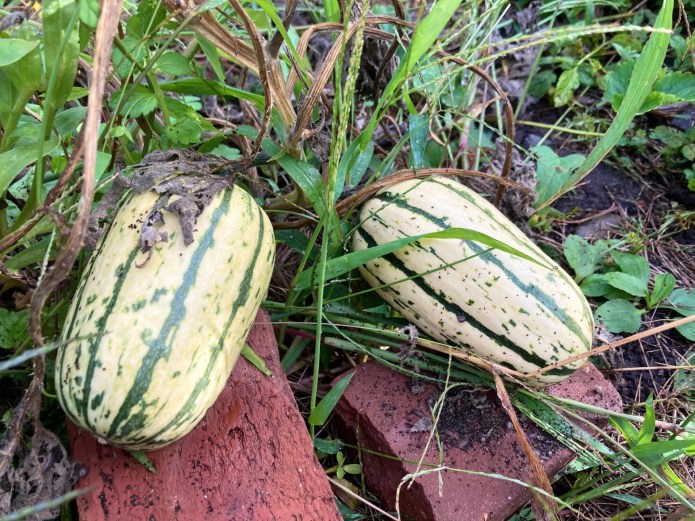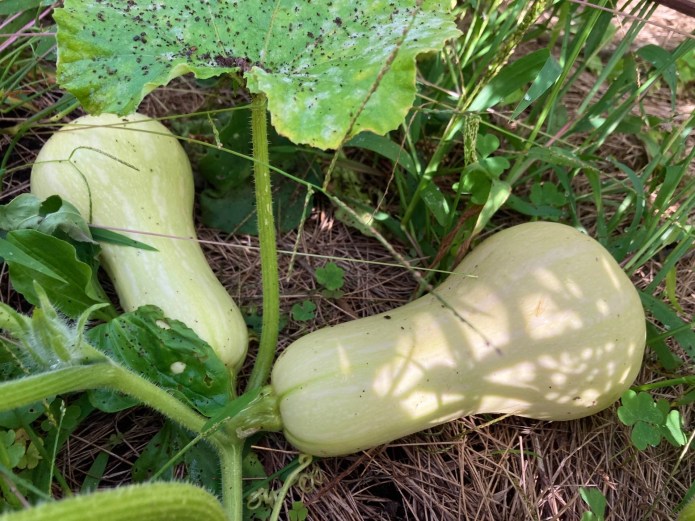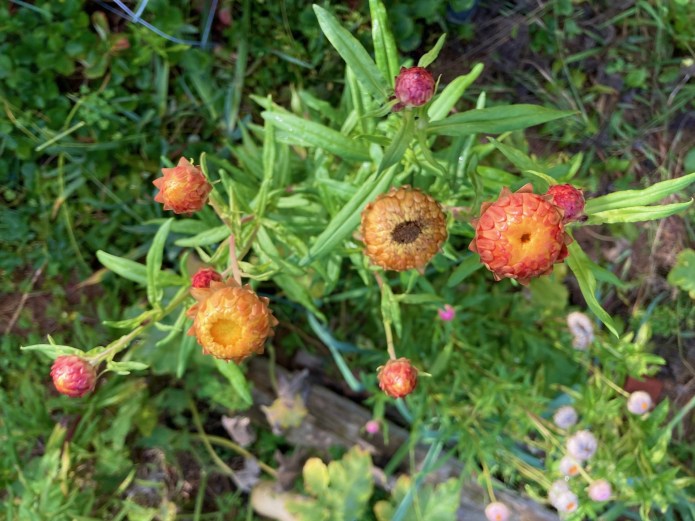
Every year in the garden is different, but 2025 was a weird and in part downright disappointing year in my community plot. There were many fails, but also some highlights.


Fruiting crops (tomatoes, cucumbers, peppers, eggplants). It was a strange year for tomatoes. I harvested my first tomato (Stupice) on July 23, and then had a fantastic, very steady supply all through the month of August. I harvested at least two pounds every other day. Which was great. But then, production dropped off sharply by early September, and with the early tomatoes done, the Ananas Noire and Black Krim developed some type of rot. I had to pull the plants and only had a few more slowly ripening Ailsa Craig and Brimmer all through fall. I had enough tomatoes to preserve some. I made a couple of batches of slow-roasted tomatoes, and I also pickled some green cherry tomatoes (those were from the communal flower bed). The cucumbers did well. This year, I only planted mildew-resistant varieties (Diva, a slicer and Max Pack, a pickling cucumber), and that really made a difference. I had more pickling cucumbers than slicers, and that is just fine with me. The cucamelons did okay. Not enough plants to really have a significant harvest. For peppers, it was Thai peppers only. They were tiny but super potent. I had two plants in the plot and one in a container on the porch. I ended up drying them. No eggplants his year.

Squash. 2025 marked the first year I successfully grew Delicata squash. Hallelujah! As with the cucumbers, I only grew mildew-resistant squash varieties, and that really seemed to pay off. On the downside, all my squash plants took forever to grow and set flowers. Therefore, they set fruit very late, and the squash I harvested were much smaller than normal. I had one zucchini plant, and it did not do great. It grew very slowly and set fruit surprisingly late, but it was also a very different variety than usual.

Root vegetables. I only grew radishes (French Breakfast) and only on the back porch. Those were fantastic as usual, and they always make me so happy in early spring. I sowed the fall beets too late in late summer and then (because of traveling and other issues in the fall) was not able to thin them and take care of them properly. No carrots this year.

Brassicas. I again only planted kale this year, several plants of Meadowlark, a tasty green curly variety. It did great as usual, but also needed to be fenced in as the rabbits were very interested. I noticed far fewer aphids this year. Perhaps this was due to the calendulas which grew nearby? Calendula is known to serve as an effective trap crop.

Greens and lettuce. I had a row of Swiss chard, which grew super slow (except for one plant for some reason), so I only had a small harvest. I planted lettuces in containers on my porch and also (fenced in) in the plot, and they all did really well. The spring arugula on the back porch did great too. No spinach or fall greens.
Legumes. I did not grow any peas or beans this year.

Alliums. It was a fantastic year for garlic. My garlic is getting bigger every year, because I always save the largest heads as seed garlic. I also planted shallots in the spring and had high hopes as they were sprouting nicely. I ended up with only three (!) shallots as most of them were eaten by critters, which was a bit of a surprise. I did not think I needed to fence them in, but the rabbits seemed to enjoy the tender shallot shoots. I will try shallots again next year, this time protecting them with chicken wire. For the first time, I made garlic scape powder in addition to garlic scape pesto. A very good idea.

Sweet potatoes. First time ever trying to grow sweet potatoes and it was a formidable fail. To be fair, I only had one plant (it was a pilot project after all), but I don’t think I took care of it properly. I did not hill it, etc. I harvested about six or seven small tubers, some of them with holes thanks to some soil-dwelling critters. I contemplated curing those tubers but ended up composting them. It would have been too much of an effort.

Flowers. This year was all about calendula (more posts on this later). But I also grew strawflowers (which I truly loved and used around the house and incorporated in this year’s garlic braid) and zinnias. And there were marigolds and nasturtiums of course. The borage came up late and never really flowered. I only had three surviving dahlia tubers, which went into the communal flower bed, as did the alyssum, gomphrena, okra, and many more zinnias and strawflowers I grew from seed.

Herbs. My herbs did well this year. In the plot, I had several rows of Thai basil and Italian basil, the latter interplanted as usual with the tomatoes. I made several batches of both Thai basil pesto and regular basil pesto. I also had a sage plant in the plot, which unfortunately died. The parsley in the plot did well this year. On my porch, I had three parsley plants as well as Italian basil and Thai basil and other kitchen herbs.

Ginger. Big fail. I honestly am not sure what happened. It had a very promising start, but I may have put it outside too soon. It just turned yellow and died. I am not sure I will try again next year.

Perennials. I harvested the first real rhubarb this year (meaning several rounds) after I had put the plant in in 2022. It is finally mature enough, yay! I made a super delicious rhubarb crisp, and we also made strawberry-rhubarb compote a couple of times. I am so happy that I finally can harvest enough rhubarb again.

Porch. As in previous years, I grew mostly herbs and flowers on my back porch. This year, I had parsley (3 plants), Italian basil (2), Thai basil (2), and smaller containers of rosemary, thyme, sage, chives and lavender. There was one large container of flowers, which went from spring bulbs to zinnias. I also grew radishes, arugula and lettuce (all in the spring), and Thai peppers in the summer. The Thai peppers were interplanted with Thai basil and nasturtium. And there were three grow bags with asparagus and cosmos. Overall, a very nice mix of herbs and color.

New communal flower bed outside the community garden. I was counting on having dahlias again, but that turned out not to be the case (both because most of my tubers died over the winter, and the person, who so generously loaned hers last year found a more suitable place for her operations). So, the bed looked different than last year. The perennials did great and all came back. As did the hundreds of spring bulbs we planted the previous fall (well, only the tulips really pulled through, the crocuses fell victim to the bunnies). We had several cherry tomatoes, herbs, Swiss chard, eggplant and okra plants. For flowers, all my alyssum, gomphrena, many strawflowers and zinnia seedling, as well as dahlias and calendula transplants, and cosmos, nasturtium and a wildflower mix went into the bed (the last three were sown directly.) We also grew cardinal flower (?) and another lovely climber up the fence, and some other donations by gardeners. The bed looked very different than last year but was just as colorful and beautiful.

Plans for 2026. Next year, I want lots of flowers again and will focus on tomatoes, greens, basil, Thai basil, pickling cucumbers, squash, beets and leeks in the plot. I will also try shallots again. In 2025, I had 11 tomato plants (8 varieties, a mix of early, mid-season and late tomatoes). I plan to plant the same amount again next year. I will definitely plant hot Thai pepper again on the porch (not sure whether also in the plot), but really should amend the soil in the container before planting. I have not decided whether I will grow eggplants again. I really love them, so perhaps a few (4 or 5) Asian-style varieties. I plan to have four (or so) pickling cucumber plants and two (or three) slicers. Probably no cucamelons. I will grow one zucchini again and also many winter squash, Butternut of course and Delicata. I will try to start them earlier next year to make sure they have plenty of time to grow and set flowers and fruit. I will grow radishes (French Breakfast) on the porch only, and a few different beet varieties in the plot. Perhaps carrots for fall harvest. I plan to have four or five Lacinato kale plants (but likely no other brassicas) and rainbow Swiss chard in the plot (about six plants). I will grow different kinds of lettuces on my porch and in the plot. I will also definitely plant my trusted fall greens mix. Perhaps fall spinach. Not sure about peas. I would need to net them to protect them from the birds, which is a bit of a hassle. Likely no beans, as those would need to be fenced in. The garlic is already in the ground, and I plan to grow shallots again and leeks as well. Probably no ginger or sweet potatoes next year. I will definitely grow cutting flowers: zinnias, cosmos, dahlias (fingers crossed they survive), and strawflowers. And calendula, which should self-seed. I also need to establish borage again. And for pest control, I will plant nasturtium and marigold. For herbs, I will continue to have my container kitchen garden on my back porch: basil, Thai basil, parsley, sage, thyme, rosemary, mint, chives (?). In the plot, I plan to grow Italian basil, Thai basil, parsley, sage and cilantro. There also will be mint and lemon balm. As for perennials, I am looking forward to my rhubarb. On my porch, I plan to have herbs, hot peppers and flowers (Alaska nasturtium, cosmos, zinnia, lavender). And lettuces and/or arugula and radishes in the spring. For the communal bed, I am planning to start many flower seeds in the spring, including snapdragons. I am looking forward to a bountiful 2026!

































